Introduction
The Battle of Red Cliffs (Chìbì zhī zhàn 赤壁之戰) was one of the most important episodes of war in Chinese history. This battle, of epic dimensions, marked, in some way, the end of the Hàn 漢 dynasty (206 BC-220 AD) and the beginning of the Three Kingdoms Period (Sānguó Shídài 三國時代; 220-280).
The battle pitted the mighty army of Cáo Cāo 曹操 against the allied troops of Liú Bèi 劉備 and Sūn Quán 孫權, the latter being overwhelmingly outnumbered...
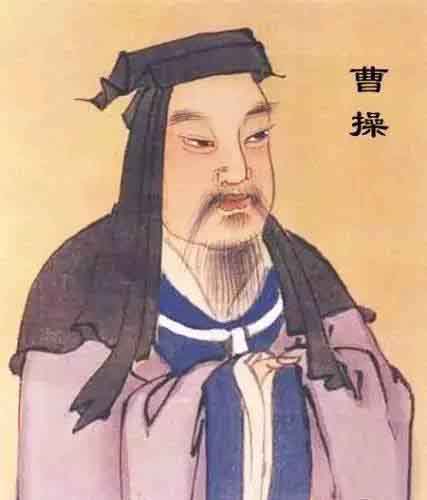
Cáo Cāo 曹操.
Historical background
We are in the second century of our era. The Hàn dynasty, after four centuries in power, begins to show signs of weakness.
In the capital, palace eunuchs have been gaining influence, to the point of pulling the strings of the imperial court and deciding appointments to official government posts. These positions begin to be directly purchased from the eunuchs, and are consequently occupied by members of wealthy families without preparation for the position.
Faced with this situation, the once effective administration of the empire becomes inefficient and corrupt. This gives rise to several revolts, the most important being the so-called Yellow Turban Rebellion (Huáng Jīn Zhī Luàn 黃巾之亂). In the suppression of this rebellion, two of the leaders who would later participate in the Battle of the Red Cliff stand out: Cáo Cāo and Liú Bèi.
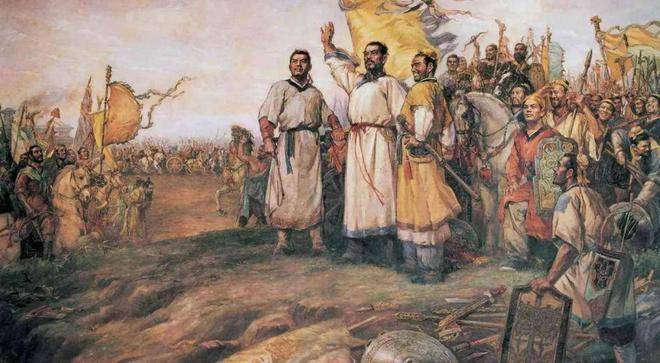
Yellow Turban Rebellion (Huáng Jīn Zhī Luàn 黃巾之亂).
After the end of the rebellion, some of the regional governors who helped suppress it begin to administer their territories according to their own wishes, without submitting to the authority of the court, giving rise to warlords fighting for their own interests.
Intrigues for power follow one another. The emperor eventually falls under the power of a series of warlords who dispute for controlling him, because whoever controls the emperor will have de facto control of the empire. From now on, the purpose of freeing the emperor becomes the legitimizing pretext of successive campaigns, by leaders who, after all, seek to assume power themselves.
Finally, Emperor Liú Xié 劉協 (Hàn Xiàndì 漢獻帝) falls under the control of Cáo Cāo, who, under the pretext of protecting him, thus legitimizes his own power. Of course, the emperor is nothing more than a puppet in his hands.
In the following years, Cáo Cāo accumulates power and takes control of all of northern China, becoming the most powerful figure in the broken empire. While Cáo Cāo is held, in the popular imagination, as one of the greatest villains in Chinese history, due to his ambition for power, it is also true that all his rivals had similar aspirations. It is also fair to say that Cáo was a brilliant man, of uncommon intelligence, and a magnificent strategist.
Having secured his control over the north, Cáo Cāo goes south with the intention of subduing other rulers who confront him under the pretext of freeing the emperor and restoring the Hàn dynasty. One of these leaders is Liú Bèi, a distant relative of the imperial family.
After suffering some defeats, Liú Bèi retreats to the south, where he forms an alliance with Sūn Quán, lord of the state of Wú 吳. This alliance will face Cáo Cāo in the Battle of the Red Cliffs, which we will describe below.
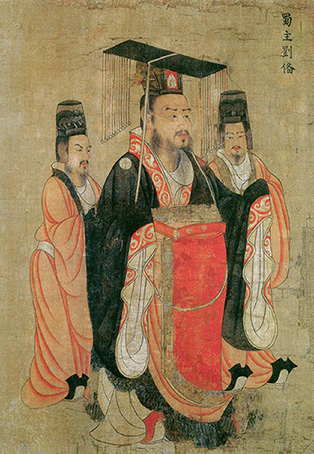
Liú Bèi 劉備.
The Battle of Red Cliffs
Towards the end of 208, Cáo Cāo launched a campaign with the intention of seizing the territories south of the Yangtze (Cháng Jiāng 長江), with a large army. Against him he has certain unfavourable conditions: the fatigue accumulated in his march from the north; the southern climate and terrain, to which his men are not accustomed; and some tropical diseases to which they have no immunity, which deplete their troops.
Cáo, throughout his previous victories, has acquired a good number of warships that he intends to use in the campaign. But his men, who are land troops and not used to fighting on ships, get seasick easily. Most of them, in addition, only have a few days of training in naval operations.
To his favour, he has an overwhelming numerical superiority. The most realistic estimates calculate he had around 250,000 men, although some sources speak of up to 800,000. In front of him are the troops who have been able to muster the southern alliance: some fifty thousand men, a far inferior force. But, among these men, in addition to the aforementioned Sūn Quán and Liú Bèi, are the legendary warrior Guān Yǔ 關羽 and the famous strategist Zhūgě Liàng 諸葛亮, in the service of Liú Bèi, and the general Zhōu Yú 周瑜, another great strategist, in the service of Sūn Quán.
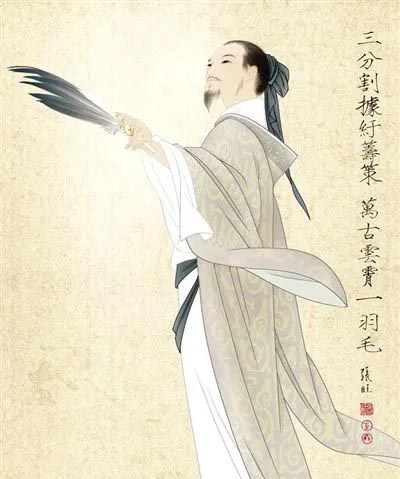
Zhūgě Liàng 諸葛亮.
In the winter of 208, the forces met on land near the Red Cliffs (Chìbì 赤壁). Without either side being able to gain an advantageous position, both retreated, with Cáo Cāo taking refuge in nearby Wūlín 烏林.
In the Romance of the Three Kingdoms (Sānguó Yǎnyì 三國演義), one of the four great classical works of Chinese literature, the narrative of the Battle of the Red Cliff mentions an episode that, although fictional, we would like to tell here.
With Sūn Quán's general Zhōu Yú in rivalry with Zhūgě Liàng's ingenuity, he gets Liàng to accept the order to reverse the shortage of arrows in the allied army, procuring one hundred thousand of them within three days. An order completely impossible to fulfill, at least apparently. Zhōu Yú's intention is actually to execute Zhūgě Liàng under military law when he proves unable to comply with the order.
Zhūgě Liàng orders a flotilla of small boats to be filled with straw dummies and, on a night of dense fog, approaches Cáo Cāo's fleet. The enemy camp raises the alarm when they spot the boats, but, unable to see through the mist, they fear that behind the small boats is a much larger fleet. That is why, instead of engaging the boats in direct combat, Cáo Cāo orders them riddled with arrows.
Arrows are stuck in the boats, as well as in the straw men. Zhūgě exposes the sides of the shios until they are filled with projectiles from both sides, after which he returns to the camp with the boats loaded with enemy arrows, and thus fulfilling the mission entrusted.
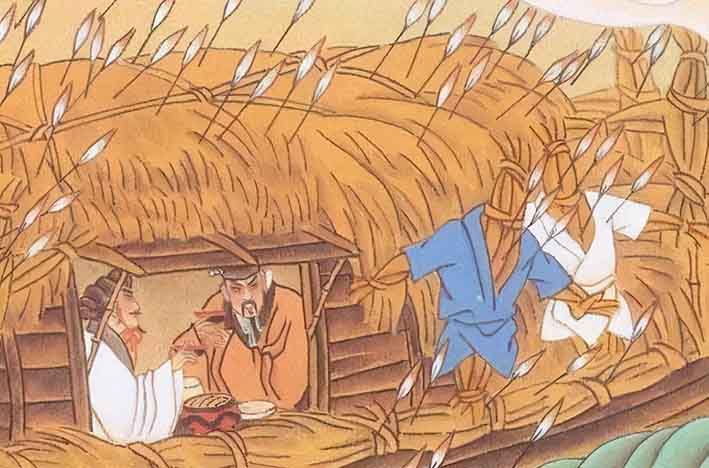
While at his base in Wūlín, Cáo Cāo receives a letter from a commander of Sūn Quán's forces, named Huáng Gài 黃蓋, offering to surrender to Cáo's side under the pretext of having been wronged by his superiors. Cáo accepts the surrender, and Huáng Gài agrees that he will join him with his forces as soon as possible.
Something that Cáo Cāo did not know was that the supposed surrender of Huáng Gài was not such. He had ordered a squadron of ships to be filled with incendiary materials and, using the tailwind, sent them towards the enemy ships feigning surrender. Halfway through, his men set fire to the ships, and escaped in smaller boats.
The strong wind blew the burning ships to Cáo Cāo's fleet. Probably because his men suffered from seasickness, as they were not accustomed to sailing, Cáo Cāo had joined his ships to each other, to form stable platforms that would not affect the condition of his men. When the fire ignited in their boats, they could not maneuver and were consumed by the flames.
When the northern fleet was burning, and the flames had even reached their camps on land, the allied troops launched their attack, taking advantage of the chaos and obtaining a great victory.
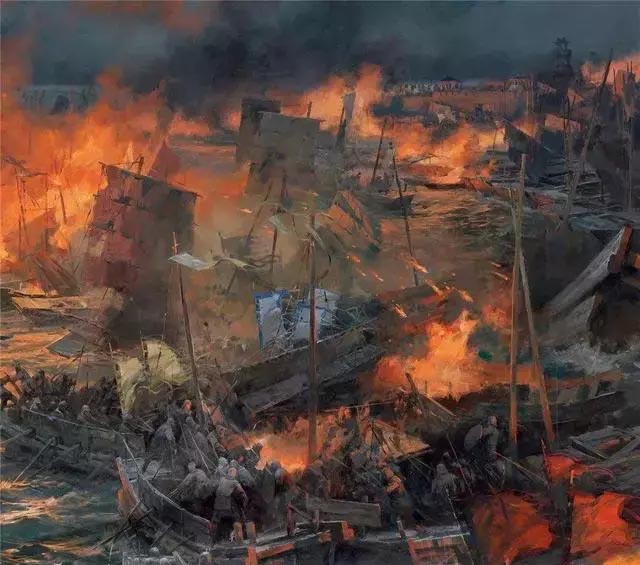
We don't know exactly where the battle took place. The course of the river has changed over the centuries, as well as the names of the places. From records of the time it is known that it was on the south bank of the Yangtze, south of present-day Húběi 湖北 province.
Among the possible places, there is one, in Púqí 蒲圻, which has inscriptions engraved on the cliff wall that mark it as the place of the battle. However, these engravings were made between the Táng 唐 and Sòng 宋 dynasties and, despite being ancient, were made many centuries after the battle.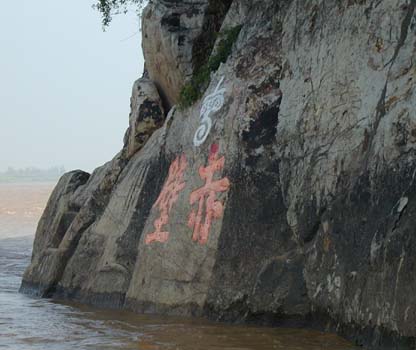
Realizing the defeat, Cáo ordered the retreat along the road to Huáróng 華容. The terrain was muddy with rains and his troops, making a great effort to advance, were pursued by the rival army, suffering great damage and, although Cáo managed to avoid a complete defeat, battle, hunger and disease took a heavy toll on his army.
Despite Cáo Cāo's great intelligence, in this episode he shows a lack of foresight that leads to a series of disastrous mistakes. First, to convert its ground troops into a naval force with no experience in this field; second, to present battle with his men weary by the long march from the north; and finally, holding the boats to each other since, despite providing stability, it made it difficult to maneuver. These mistakes are in addition to a number of unfavourable conditions, namely the relative lack of support in the region, climatic conditions to which their soldiers were not accustomed, and the emergence of diseases.
Conclusions
Cáo Cāo's defeat at the Red Cliffs reduced his territory and influence. After this severe setback, he will never have an equal opportunity to destroy his rivals and thus unify China under his rule.
A few years later, this balance of power led to the configuration of the Three Kingdoms (Sānguó 三國): Cáo Wèi 曹魏 in the north under the lineage of Cáo Cāo; Shǔ Hàn 蜀漢 in the southwest, with Liú Bèi as emperor, and the aforementioned state of Wú in the southeast which, although it already existed as a vassal kingdom of Cáo Wèi, proclaimed its independence in 222.
This is the end of the Hàn dynasty, and the beginning of the Three Kingdoms Period.
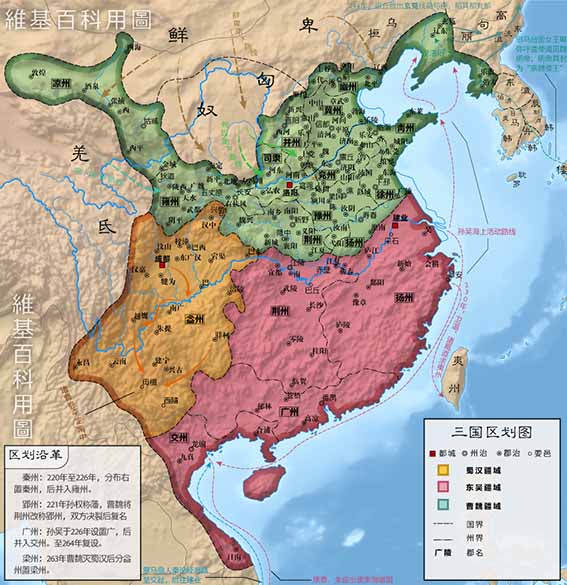
The Three Kingdoms (Sānguó 三國): Cáo Wèi 曹魏 in the north; Shǔ Hàn 蜀漢 in the southwest, y Wú 吳 en el southeast.
Sources:
Romance de los Tres Reinos, Luo Guanzhong. Penguin Books Limited, 2018.
Decisive Battles in Chinese History. Morgan Deane, 2017, Westholme Publishing.
